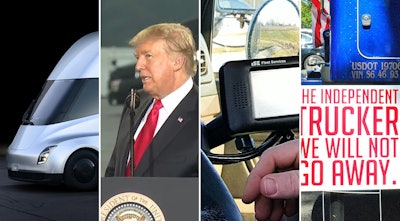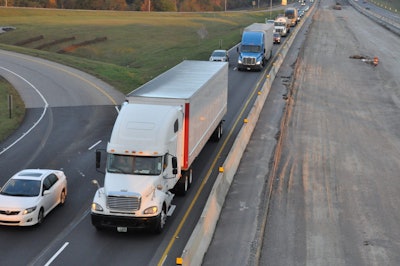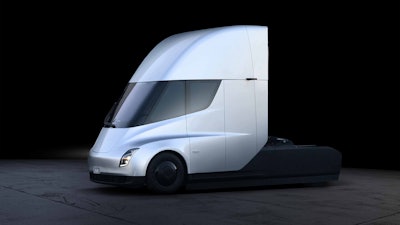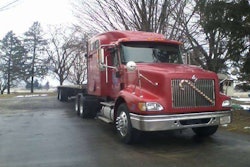
A quick look at the 2017 analytics for Overdrive shows an unsurprising insight: coverage of the U.S. DOT’s electronic logging device mandate stole the spotlight from the year’s start to finish.
Coverage of the mandate and its myriad of twists and turns dominated the news cycle throughout 2017. It also dominated Overdrive’s usual in-depth coverage of the industry, with Senior Editor Todd Dills, among others, penning several examinations of how the mandate is likely to affect trucking and owner-operators. (See a full list of those stories here in the E-Log Shift series.)
While the ELD mandate commanded the industry’s attention this year, other trends in the year emerged, too. Below is a look at some of those trends, with links to the pertinent articles published here on Overdrive in the year. For a full review of 2017, broken down in a month by month look at the year’s top stories, see Overdrive Associate Editor Matt Cole’s year in review coverage at this link.
The year of the ELD — mandate descends despite protests, appeals to the Supreme Court, action in Congress and swirling enforcement questions.

The two main trends surrounding the ELD mandate in 2017 included the mechanics of the mandate itself, such as enforcement questions and compliance options, and the efforts of those hoping to topple, or at least delay, its implementation. Dozens, if not hundreds, of ELD-related stories hit the pages of Overdrive this year. Below is a recap of the high notes.
**
Of note from an enforcement perspective, the Federal Motor Carrier Safety Administration and the enforcement partnership of state and industry in the Commercial Vehicle Safety Alliance announced measures to take a soft approach to enforcement in the months after the December 18 compliance deadline. CVSA said it wouldn’t be issuing out-of-service orders for noncompliance until April 1, and FMCSA followed by announcing ELD infractions wouldn’t count against carriers’ CSA scores until April 1. FMCSA also issued a 90-day waiver of compliance to certain livestock and ag haulers, giving them until March 18 to adopt an ELD.
Many states themselves, likewise, are taking soft and/or not-so-soft approaches to ELD enforcement, covered in-depth here by Overdrive’s Todd Dills as the mandate’s deadline hit. Though all are enforcing the mandate, some are taking a more lax approach than others for the first few months.
The mandate’s December 18 compliance date held despite ramped-up efforts in the year by truckers, trade groups and others who sought delays — or scrapping the mandate outright.
The Owner-Operator Independent Drivers Associations led the anti-ELD charge on the governmental front by lobbying Congress and the courts to provide ELD relief. For instance, the group filed an appeal with the Supreme Court asking it to hear its case against the mandate after the 7th Circuit Court of Appeals twice ruled against OOIDA. The nation’s high court declined to hear the Association’s case.
An OOIDA-backed bill was introduced in Congress by Rep. Brian Babin (R-Texas), who proposed delaying the mandate’s compliance date two years, to 2019. The bill saw no action in Congress.
Truckers, too, formed grassroots anti-ELD groups (notably, ELD or Me and Operation Black and Blue) and held multiple days of protests in Washington, D.C., in October — joined by many around the country and with significant demonstrations in California as well — hoping to have their concerns about the mandate heard by Congress, the DOT and anyone else who would listen. Other protests/anti-mandate media-outreach efforts were held across the country then in early December. See coverage of some of the year’s protests at the links below.
Trump and trucking — DOT scales back regulatory efforts with new president at the helm.

Freshly inaugurated President Trump began immediately signing Executive Orders in January targeting federal regulations. What impact those orders had on trucking is up for debate, but FMCSA in 2017 did strike a few trucking regs in the works by the Obama Administration. Trump’s EPA also repealed emissions regulations that likely would have been the end of the glider kit industry as it exists today.
FMCSA also rescinded several proposed rules. Here are the headlines throughout the year:
Trump DOT nixes sleep apnea rulemaking, bumps speed limiter mandate
EPA officially proposes killing regs that threatened glider kit trucks
FMCSA withdraws rule reforming carrier safety rating system
FMCSA officially nixes rule on increasing liability insurance required for carriers
FMCSA puts final nail in the coffin for restart regs (see more below in the Honorable Mention section)
Trump on more than one occasion mingled with trucking industry representatives, mostly in ATA-organized events. In March, Trump spoke to a group of drivers inside the White House. The drivers, mostly captains from ATA’s America’s Road Team group, talked healthcare reform, with an Obamacare repeal bill in the works in Congress at the time. He also climbed aboard an ATA-emblazoned Mack Pinnacle parked in front of the White House and put on a small show for the attendees on hand.
In October, Trump spoke to an ATA-organized group of fleet executives and drivers at an airport tarmac in Ohio, which hardened the heart of anti-ELD mandate partisans. There, he stumped for the Republican tax reform plan in the works.
The rise of the electric truck — major tech players take aim at Class 8 market.

After a year of promotion and teases, electric vehicle stalwart Tesla revealed an all-electric, semi-autonomous Class 8 tractor. The rig boasts a re-imagined exterior and interior design, and Tesla touts the vehicle as one that provides both lower costs per mile and much lower maintenance costs. However, the company provide few details about the tests its performed or even basic spec info, such as horsepower and torque ratings.
Major fleets have tossed their hat in the ring, nonetheless, laying down hundreds of thousands of dollars or more to stake claim to some of the company’s first units.
Tesla’s entrance into the Class 8 market was one of several key developments on the electric truck front in 2017.
Hydrogen-electric truck maker Nikola, who introduced its Nikola One tractor in December 2016, made progress in fleshing out its fueling network.
Navistar and Volkswagen announced plans to develop an electric drivetrain. Toyota began testing an electrified powertrain under the hood of a Kenworth T660 at California ports. Cummins revealed in August an all-electric Class 7 tractor. Fuso introduced an all-electric Class 8 tractor in October. Lastly, a startup company called Thor has set its sights on the short-haul market with a battery-powered Class 8 tractor.
Rates shoot up as market swings in truckers’ favor.

After a choppy first half of 2017 (and mostly tough years for rates in 2015 and 2016), market conditions aligned well in the favor of trucking companies, and rates on the spot market, where owner-operators often work, soared in the latter half of the year. Contract rates have gained, too.
What’s more, the trend is expected to continue, with forecasters predicting rates to remain strong at least through the first half of 2018. See the latest on the freight market and rates here.
Honorable mention — Hours of service reforms tilt in truckers’ favor.

After a nearly five-year saga, FMCSA put to rest the 2013-implemented hours of service regs that required drivers’ 34-hour restarts to include two 1 a.m. to 5 a.m. periods and limited the use of a restart to once a week. Congress in late 2014 instituted the so-called “restart rollback,” which shelved the 2013 restart regs over the agency’s lack of justification for the more restrictive requirements. However, Congress called on FMCSA to perform a field study to determine whether the regs would go back into effect.
The results of the study found no safety benefit to the regs, which permanently buried them.
Also in 2017, FMCSA progressed with a study intended to test the feasibility of adding greater hours of service flexibility by way of more permissive split-sleeper-berth options. More will likely unfold on the front in the coming year. In short, the agency plans to study two groups of truckers, one operating under current hours of service regs and one operating under rules that allow drivers to split their off-duty time into segments other than the currently allowed 8- and 2-hour periods. The agency said earlier this year it intended to enter the data gathering phase in 2017. Read more on the study here.











